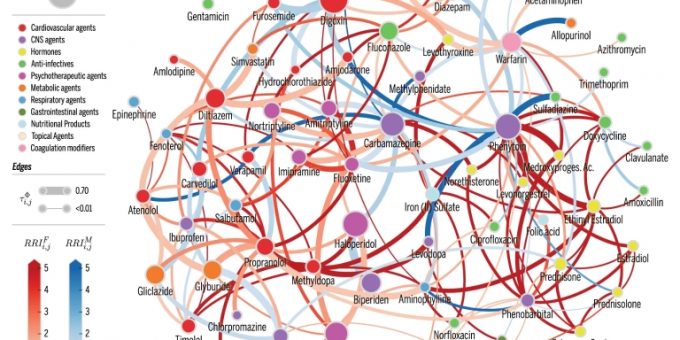
(BLOOMINGTON) – A new study led by researchers at Indiana University has found that women and older adults who use multiple prescription drugs are significantly more likely to be prescribed pills whose combination produces dangerous side effects.
News at IU Bloomington reports, the analysis, conducted in the Brazilian health care system and recently published in the journal npj Digital Medicine, revealed a 60 percent increased risk for adverse drug reaction in women compared to men — and a 90 percent increased risk in cases of medicines whose interaction is known to produce dangerous reactions. In older people, one in every four people prescribed multiple medicines over age 55 received drugs with an interaction — reaching one in every three for ages 70 to 79.
A total of 181 drug combinations prescribed against recommendations were uncovered. These medications, widely known to interact dangerously, were dispensed to 15,527 people among the study’s population, including 5,000 who got drug combinations known to cause major complications likely requiring medical attention.
“These results are surprising — shocking even — since it’s no secret these drugs aren’t supposed to be prescribed in combination,” said Luis Rocha, a professor in the IU School of Informatics, Computing and Engineering, who is the senior author on the study. “We expected some elevated risk in the elderly since they use more medications, but not this high. The gender bias was completely unexpected.”
According to the U.S. Department of Health and Human Services, about one out of every three hospital visits annually are related to adverse drug effects, which include adverse drug reactions. Another analysis of adverse drug reaction in Ontario, Canada, placed the cost of these incidents at nearly $12 million per year — or $1 per capita — for that province alone. In other countries, such as the U.S., the IU-led study’s authors estimate costs could run as much as seven times higher per capita.
The new analysis is based upon health records from Blumenau, a city in Brazil with a population of about 334,000. The researchers stumbled across gender- and age-based disparities in care during a general analysis of drug interactions among the city’s population in collaboration with researchers at the Regional University of Blumenau, which developed the city’s health record system. A Ph.D. student in Rocha’s lab at the time of the study, Rion Brattig Correia, previously managed the lab that created the system.
The drugs identified as most commonly prescribed in dangerous combinations were standard medications — such as omeprazole, a common heartburn medication whose brand names include Prilosec; fluoxetine, a common antidepressant whose brand names include Prozac; and ibuprofen, a common analgesic — as well as some less common drugs, such as erythromycin, an anti-infectant.
The researchers were careful to control for other factors that might result in higher risk for dangerous drug combinations, such as older adults taking more prescription drugs, Rocha said. The study compared drugs actually prescribed to older patients against a random selection of drugs common among older adults, for example, to show that dangerous drug combinations actually occurred at a higher rate in real life compared to the random model.
Although the research did not explore the cause of these higher drug interaction risks, the lack of options for certain medications under Brazil’s public health system could play a role, Rocha added. Women tend to be prescribed more antidepressants, for example, and more expensive options with fewer interactions are not available in the public health system. Similarly, older adults tend to use more medications to control cholesterol, another drug type with few public options found to occur often in dangerous combination.

“It might simply be that no other choice exists, so doctors feel that the treatment is worth the risks,” Rocha said. “Or some physicians may simply be unaware of the dangers.”
The researchers are hopeful the work might influence health policy in Brazil, Correia added, including increasing publicly available drug choices for seniors and women. He plans to delve further into the results to learn the deeper causes of these biases against women and older adults.
“Physicians and other health care professions everywhere need to understand the role of gender and age toward the risk of dangerous drug interactions for their patients,” he said. “We expect these results will increase this awareness.”
Additional researchers on this paper are Luciana P. de Araújo Kohler and Mauro M. Mattos of the Regional University of Blumenau.
IU Research
Indiana University’s world-class researchers have driven innovation and creative initiatives that matter for nearly 200 years. From curing testicular cancer to collaborating with NASA to search for life on Mars, IU has earned its reputation as a world-class research institution. Supported by $604 million last year from 868 partners, IU researchers are building collaborations and uncovering new solutions that improve lives in Indiana and around the globe.
Information – News at IU Bloomington, https://news.iu.edu/iu-bloomington/index.html





